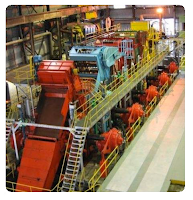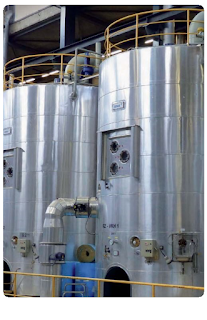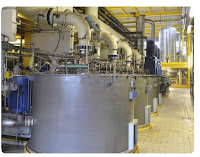 Sugar is produced in over 130 countries worldwide. Around 80 percent of sugar is produced from cane, which is grown in tropical and sub-tropical regions. The remaining 20 percent is manufactured from beet grown in more temperate climates. Refined sugar is both chemically and functionally identical whether it is produced from cane or beet.
Sugar is produced in over 130 countries worldwide. Around 80 percent of sugar is produced from cane, which is grown in tropical and sub-tropical regions. The remaining 20 percent is manufactured from beet grown in more temperate climates. Refined sugar is both chemically and functionally identical whether it is produced from cane or beet.Transportation – Cane is loaded into lorries or rail trucks and taken to the mills for processing. On arrival the cane is washed to remove rocks and leaves.
 Shredder – The shredder shreds the cane and reduces it into fibrous material to expose the sucrose bearing cells. This allows for the extraction (milling) process to maximize the removal of the sugar juice from the cane.
Shredder – The shredder shreds the cane and reduces it into fibrous material to expose the sucrose bearing cells. This allows for the extraction (milling) process to maximize the removal of the sugar juice from the cane.Milling – This is the extraction process whereby the sugar is removed from the cane. The shredded cane is crushed between heavy, grooved metal rollers to separate the juice from the fibre. The milling process involves a number of mills which are made up of three rollers arranged in a triangular formation. As the cane is crushed in the mills hot water (or recovered impure juice) is sprayed onto the crushed cane. The resultant dark green juice (sometimes called vesou) is then sent to a mixed juice tank for storage before clarification.
The cane fiber (called bagasse) is recycled as a fuel for the mill’s boiler furnaces. Importantly, milling must take place within 36 hours of the cane being cut.
Kinetrol units are used to control the flow of water to the spray system. It is necessary to ensure that sufficient water is used to remove the sugar content without flooding the cane.
 Clarification and Filtering – Clarification is where soluble and insoluble impurities (sand, soil, etc.) are removed. The vesou is heated and then lime is added to the juice. Clear sugar juice is run off from the top of the clarifier. The muddy juice, extracted from the bottom of the clarifier, is mixed with fine bagasse and filtered to recover more sugar. This process can be repeated to ensure maximum recovery of sugar. The final recovered mud & bagasse mix is used as a soil treatment on the cane farms.
Clarification and Filtering – Clarification is where soluble and insoluble impurities (sand, soil, etc.) are removed. The vesou is heated and then lime is added to the juice. Clear sugar juice is run off from the top of the clarifier. The muddy juice, extracted from the bottom of the clarifier, is mixed with fine bagasse and filtered to recover more sugar. This process can be repeated to ensure maximum recovery of sugar. The final recovered mud & bagasse mix is used as a soil treatment on the cane farms.Kinetrol units are used to control the flow of the vesou to the clarifier. Controlled flow reduces turbulence which allows for quicker settling times. Kinetrol's are also be used to control the recirculation flow of the sugar juice to the clarifier.
 Evaporation – The clear juice from the clarifier is concentrated into a syrup by boiling it under vacuum in evaporators. Around two-thirds of water in the juice is removed in the evaporation process leaving an end syrup with approximately 65-70 percent sugar content.
Evaporation – The clear juice from the clarifier is concentrated into a syrup by boiling it under vacuum in evaporators. Around two-thirds of water in the juice is removed in the evaporation process leaving an end syrup with approximately 65-70 percent sugar content.Kinetrol actuators are used to control the flow of steam to the evaporation tanks. In addition they control the flow of the juice through the evaporators. This is because of their reliability in the higher ambient temperatures in the process area.
Vacuum Pans – The syrup is concentrated further by boiling it in vacuum pans. Here it is ‘seeded’ with small sugar crystals to allow crystallization to take place. When the the sucrose concentration reaches the desired level the mixture of crystals and syrup, called massecuite, is sent to the centrifuges.
Kinetrol actuators control the input of heating steam into the pans as well as the flow of the massecuite through the process.
Centrifuges – High speed centrifuges separate the massecuite into sugar crystals and by-products (molasses).
Kinetrol actuators control the massecuite feeding system into the centrifuges. Accurate control of the valves feeding the centrifuges is necessary to prevent overloading and leakage of the centrifuges.
 Kinetrol actuators also control the water inlets of the automated wash system for the centrifuges.
Kinetrol actuators also control the water inlets of the automated wash system for the centrifuges.Dryers – Damp sugar crystals are dried in heated dryers before being sorted in sizes and either packed or stored.
Kinetrol's reliability, especially under hot, humid conditions, are crucial factors for our units being used within the sugar industry. Depending on the plant and location the actual ‘processing’ season varies from around four months for sugar beet to six months for sugar cane. During this short time it is essential that plants have no production issues as this will have a dramatic effect on the productivity and therefore competitiveness of the plant. The reliability and robustness of the Kinetrol units means they continue to function through each production season year after year.
Kinetrol’s ability to maintain an unchanged torque rating even with wear of the lip seals, means critical valves continue to function correctly over time. This is especially true with a product that is highly viscous in the later stage of production (e.g. thick juice, molasses).
With some plants being non-operational for many months of the year there does exist time for service & maintenance or replacement of rack & pinion actuators. However as margins within the sugar industry are low, the total cost of ownership for Kinetrol units over a number of production seasons makes them a more cost effective solution.
For more information, contact Kinetrol USA by calling 972-447-9443 or by visiting https://kinetrolusa.com.
